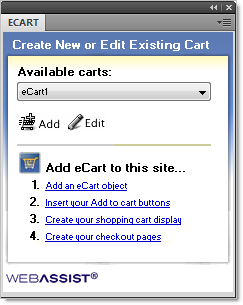Creating An eCart Object
The eCart Object maintains all of the information specific to a shopping cart configuration within your site. All pages that contain shopping cart functionality must have an eCart Object applied to the page. This provides the fundamental structure for the operation of the shopping cart.
The following sections detail how to manage, and configure the attributes of an eCart Object:
- Specifying settings for your eCart Object
- General: Defines common settings such as currency and item weight.
- Columns: Defines the columns utilized within the shopping cart.
- Calculations: Sets how totals are calculated for columns within the cart.
- Discounts, Charges, Taxes, and Shipping: Allows for creating rules to establish how charges, discounts, taxes, and shipping are applied based on criteria you specify.
Access
The following locations in Dreamweaver open the eCart Object panel. The eCart object panel allows you to manage your eCart objects, and create new ones.- eCart Insert panel/toolbar

- Insert > WebAssist > eCart > eCart Object
- Server Behaviors > eCart > eCart Object
Managing eCart Objects
The following controls are available for adding and editing eCart Objects in this panel: |
Available carts: Displays any existing eCart Objects configured for your site. These are stored in a root folder of your site that is created the first time an object is inserted into your site. Add: Opens the eCart Object user interface to specify a name and select the configuration options specific to a new eCart Object within your site. Note: You cannot change an eCart Object's name when you have completed configuration and exited the interface. Edit: For an existing eCart Object selected from the Available carts: list, this button opens the eCart Object user interface to edit the current configuration options. Can i have multiple eCart objects?It is possible to create multiple shopping carts within a single website that have different configuration requirements (for example, creating a shopping cart and a separate "wish list"). For this reason, you can define more than one eCart Object within a site, and apply multiple shopping cart instances, if necessary. |